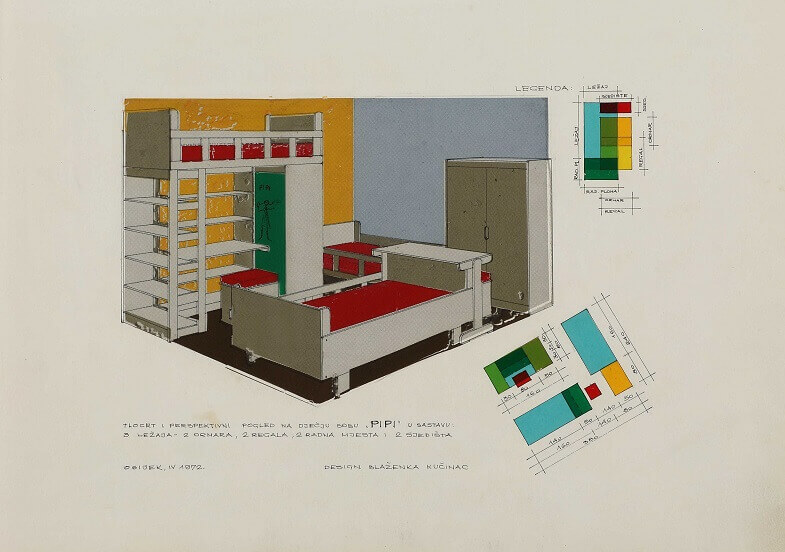The exhibition Between Wishes and Reality – the Furniture Industry and Design in Croatia 1945 – 1990, that takes place in the Museum of Arts and Crafts in Zagreb, focuses on showing the range of factory-made furniture in Croatia from 1945 to the 1990s, and it also defines the issues and contextual units of furniture industry and design. It outlines the production of some of the most important factories of this period: Mundus – Florijan Bobic from Varazdin, Mobilia – Ivo Marinkovic from Osijek, the Zagreb factories Marko Savric and Jadran, DIP Novoselec, TVIN Virovitica, Oriolik from Oriovac, Goranprodukt from Cabar, Hrast from Cakovec, and others.

Ivo Marinkovic Furniture Factory from Osijek, Catalog, 1963.
The period from 1945 to the 1990s has been chosen because it covers the existence of a particular state and political entity, and that meant a specific kind of work organization and production in furniture factories. Also, 1989 marked a turning point in the designer profession in Croatia – the foundation of Design Studies.

Goranprodukt Furniture Factory from Cabar, Sales Flyer, 1972.
It is necessary to begin by emphasizing the tradition in the wood industry and to mention some furniture factories that worked far back in the nineteenth century, and the exhibition ends by showing the current situation of the few remaining furniture factories and how they adapted to the completely changed conditions of today’s post-transitional and globalized society.

The Exhibition: Between Wishes and Reality – the Furniture Industry and Design in Croatia 1945 – 1990, Museum of Arts and Crafts in Zagreb
The problematic segments also include topics of design positions in the manufacturing process and continuous advocacy of design in the industry, as well as connecting entities in the chain design – factories – retail, the opening of the first specialized department stores and promotion of these ideas through exhibitions and trade fairs.

The Exhibition: Between Wishes and Reality – the Furniture Industry and Design in Croatia 1945 – 1990, Museum of Arts and Crafts in Zagreb
This exhibition, therefore, presents industrial furniture and accompanying documents, both of which have largely been neglected and remain material lost to cultural history and the study of design and industry, and the authors and participants in this production, who are more or less unknown to the professional and wider public. Its aim, finally, is to raise awareness of the heritage of industrial and designer furniture production – as a pledge for the present and future of industrial furniture production and design in Croatia.

Exhibition Poster
Curator and Text Author: Vanja Brdar Mustapic
Exhibition and Visual Identity Design: Ksenija Jurinec

Armchair, Design: Mirjana Maracic, Production: Mundus – Florijan Bobic Furniture Factory, Varazdin, 1975.
This design exhibition was realized thanks to the support of the Ministry of Culture of the Republic of Croatia and the City Office of Culture of the City of Zagreb. Museum of Arts and Crafts in Zagreb thanks especially to all the institutions and numerous individuals who contributed to the realization of the exhibition by lending material, cooperation, providing information and advice.
Here are two furniture design stories.

Photo: Vedran Benovic
CHAIR Modres
Design: Mladen and Marijan Oresic, 1983.
Factory: TMN Jadran, Zagreb
Material: integral polyurethane or wood, metal tubes
In the 1980s, Mladen Oresic, working with Marijan Oresic, developed three very successful programs: Ergoline (1981 – office furniture), Modres (1983) and Uni 87 (1987). For a while, Mladen Oresic was employed at the factory and had its scholarship, but he was also a freelance designer. He worked in the Developmental Department, which was then made up of about 20 experts of various profiles: engineers, technologists, constructors and a team in the prototype workshop.

Photo: Vedran Benovic
Modres was designed for catering facilities, but its use spread to various public and private spaces. It can be dismantled and is standardized, thus functional, economical for storage and transportation, and had its own packaging. The parts were produced in various materials and colors, with or without armrests. It was the first on which the integral polyurethane technology was applied (the prototypes of these elements were made in Jadran, mass production was in Germany). In the best of times, it was produced in a series of 12,000 pieces a month. It is still part of the furnishing in many public areas (Design Studio, Student Centre, MUO, etc.). It won many awards: Golden Key, Belgrade Furniture Fair (1983), Zagreb Salon (1986), Mobil Optimum, Zagreb Fair (1987).

Designs for the Children’s Room Pipi
Design: Blazenka Kucinac, 1972.
Factory: Mobilia – Ivo Marinkovic, Osijek
Photo property of Blazenka Kucinac, Zagreb

The modular children’s room Pipi could change and “grow up” together with the child, from birth to the teens. The cradle/crib could be transformed into a storage closet, the length of the bed extended from 150 to 200 cm, the desk could be adjusted to four heights, the cube was a chair with three possible heights, and the side of the bed coincided with the side of the shelf and could be used as a ladder when there was a bunk bed. The back of the closet doubled as a school blackboard. When arranged the furniture takes up a minimum surface area of 1.5 m² in the usual layout. It was mass-produced in the Novi Marof plant. The innovative and functional design won awards (the Good Design Diploma from the Belgrade Design Centre in 1972 at the Tenth International Fair of Furniture, Furnishings and Interior Decoration in Belgrade).
Cover Photo – Armchair, Design: Vlado Petricevic, Production: Furniture Factory Oriolik, Oriovac, 1972.
Designer Outdoor Furniture by 3LHD – Umomoku Collection – read on.
Office Design Project – Creative and Natural Workspace Ideas – discover more.
A Colorful Journey to Dalmatia – have a look.
